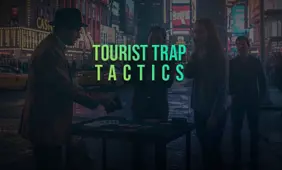R. Paul Wilson On: Uncovering Jam Auction Scams

Recently, we’ve discussed how potential victims might be approached and manipulated into unexpected situations beyond their control. We’ve used simple scams to explore how human nature and psychology might drive us off a cliff but the Jam Auction is one of the best examples of a con game in action to help us understand how con games work. In this article, we will go inside the auction to see how scammers operate and then consider how similar tactics might be used against us in the digital domain.
Jam Auctions can take place in markets, state or county fairs and big city high streets where vacant stores might be rented on a short-term basis to take advantage of large passing crowds and a sense of legitimacy that comes with a premium location. Oxford Street in London might seem an unlikely place to find professional pickpockets and grifters operating under the noses of local authorities but over the years, I’ve seen several fake auctions or scam pitches pop up, especially in the months before Christmas when crowds are bigger and the desire to find a bargain stronger.
Once lured into stores by leaflets, posters and sidewalk hustlers, victims find themselves in a dark space with windows blacked where hustlers begin the process of controlling everything they see and hear. The rooms are often crowded with auctions held off until there are enough people to make the space slightly uncomfortable.
The back wall is usually stacked with boxes for products like televisions, PlayStations, cameras and iPads as a visual hook that keeps people waiting in the hope of a quick bargain. With enough people inside, doors are closed, and the process of breaking down the crowd’s resistance begins.
Phase One: Priming the Pump
First, not everyone in this dark space is a real “punter”. Many are “shills” employed to be part of the scam, essential to what’s about to happen and to help break the ice. Marks (potential victims) are curious but naturally suspicious and (mostly) reluctant to get involved until they believe the auction to be legitimate, but they are also hopeful they can win one of the lots being displayed so prominently.
The auctioneer (also called a “barker”) begins with a few introductory comments to explain how and why this pop-up store exists, anticipating any questions the crowd might have while getting quickly to the matter at hand. This first step is to verify bargains can apparently be had but also to profile the crowd, spot easy targets and identify potential troublemakers.
The auctioneer grabs a box - perhaps a high-end Bluetooth speaker - and asks one of his helpers how much it would cost in a typical high-street shop before offering it for half that price to the crowd, but unlike a typical auction where prices go up, he immediately cuts the price even further, ignoring any raised hands before lowering the price again, taking the first hand raised as a sale!
This is such a simple way to rope the crowd, pull them tighter into the scam and encourage people to come closer to the podium (and each other). This is psychological, just like the role of the ego in gambling. The plan is to train the crowd how to behave and what to expect while members of barker’s crew observe who seems easiest to “pop” and who might hold out, speak up or challenge what they’re seeing.
That first hand to be raised once the price is lowest receives that item in return for cash, the winner is obviously delighted with their purchase, just like every other time they “won” in every other auction; real items always go to “shills” - people planted in the crowd to get the action started - and only these shills receive expensive goods, which are later returned and recycled for the next auction.
This process might be repeated several times with different shills taking part as more and more “real people” compete for increasingly expensive merchandise until the crowd is desperate for more stuff!
Along the way, suspicious people may be asked to leave (as I was on several occasions), while more susceptible victims may be moved to the front or herded together. At the end of this phase, doubts are long forgotten as people become increasingly eager to get out with a real bargain.
Phase Two: Building Pressure
With his crowd pushing and shoving and raising hands to compete for each item, in some cases, the auctioneer will introduce “blind” items, which he uses to create a counterfeit guarantee, weed out any lingering doubts people may have and disarm their money management skills.
A typical example works like this:
The barker holds up a black bag that he says has something inside and would like to know who will pay a hundred pounds for the unknown contents. This interrupts the flow of high-end items but is an excellent way to spot who is unconvinced until they see someone (a shill) pay for the bag and find a brand-new iPhone inside!
After a few more standard lots, this “black bag” deal is repeated, but this time, one of the marks is sold the bag and is disappointed to find an electric hand blender or similar item that isn’t so attractive and certainly isn’t as big a prize as an iPhone! The auctioneer makes a big show of noticing how the recipient is disappointed, so immediately gives him a refund AND lets him keep the blender as a powerful illustration of fairness that can sway even the most suspicious of onlookers.
A few more lots are sold - each being won by a shill to further frustrate the balance of the crowd, push them deeper into a psychological corner where victims become desperate to bid on anything that looks like a bargain - and that’s what happens next.
Phase Three: The Release
After almost ninety minutes of being teased and seeing other people win amazing lots for incredible prices, the crowd of marks is ready to be taken to the cleaners as the auctioneer introduces an expensive-looking camera in a convincing box with extra lenses, a case and a familiar-sounding brand name.
Every hand in the room is poised to shoot up and buy this item and when they do, each and every one of them is given a laminated voucher in exchange for cash as the auctioneer’s “staff” collect thousands in seconds! Before anyone can question this change in procedure, the auctioneer points to a stack of boxes near the door, each containing the same camera just shown, and people are hustled quickly to the exit where their laminated voucher is exchanged for one of the boxes as they stumble back onto the street.
Only once people are outside the auction room, in the fresh air, do they have a chance to examine what they just purchased and discover a piece of plastic crap not even suitable for a child to play with! At this point, no one will be happy with their purchase, yet few bother to complain, while those who do quickly give up when they meet the heavier end of the Jam crew.
Bottom Line
These three phases are all about manipulating people based on dependable aspects of human nature yet most commentators on cons, deception and scams are distracted by fake merchandise or what the marks are told without realizing how devilishly simple the real scam is.
This scam is an evolution of “The Bouncer” which tricked people into dropping increasing amounts of money for a bag of cheap crap before pulling the rug and taking the crowd’s money. This version employs similar methods but cranks the psychological pressure for a bigger return and a harder sting.
Of course, most people will never walk into a live jam auction but these same principles can be found online and in our next article, we will explore how identical tricks can be fashioned into a workable con game to capture a much richer crowd using modern “merchandise” in the form of digital currencies or tokens to bait the hook.





Review this Blog
Leave a Comment
User Comments
comments for R. Paul Wilson On: Uncovering Jam Auction Scams